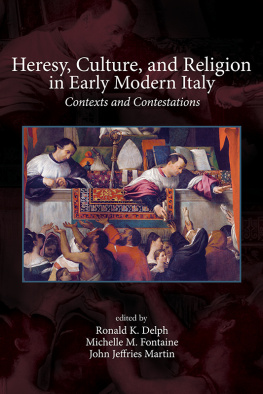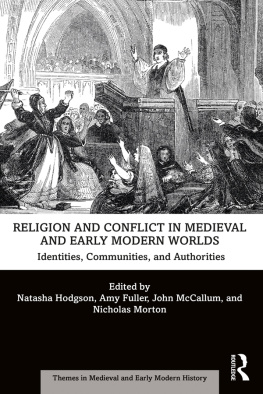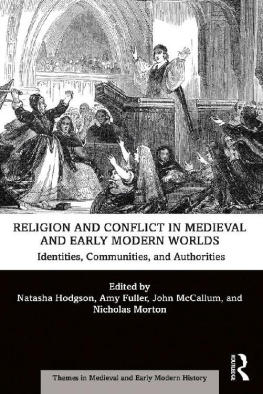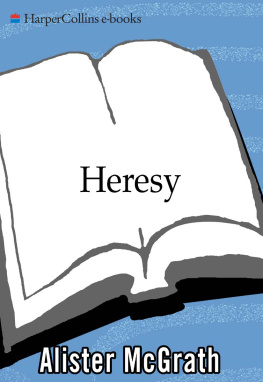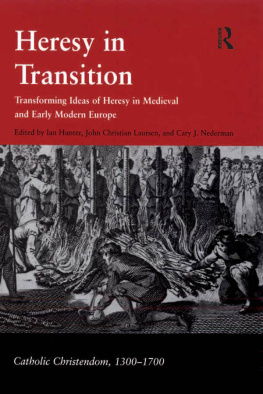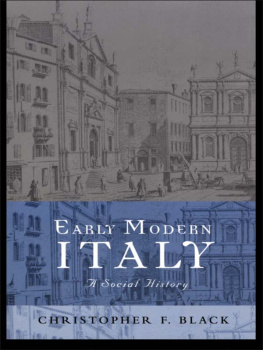Ronald K. Delph - Heresy, Culture, and Religion in Early Modern Italy
Here you can read online Ronald K. Delph - Heresy, Culture, and Religion in Early Modern Italy full text of the book (entire story) in english for free. Download pdf and epub, get meaning, cover and reviews about this ebook. year: 2015, publisher: TrumanStateUP, genre: Religion. Description of the work, (preface) as well as reviews are available. Best literature library LitArk.com created for fans of good reading and offers a wide selection of genres:
Romance novel
Science fiction
Adventure
Detective
Science
History
Home and family
Prose
Art
Politics
Computer
Non-fiction
Religion
Business
Children
Humor
Choose a favorite category and find really read worthwhile books. Enjoy immersion in the world of imagination, feel the emotions of the characters or learn something new for yourself, make an fascinating discovery.
- Book:Heresy, Culture, and Religion in Early Modern Italy
- Author:
- Publisher:TrumanStateUP
- Genre:
- Year:2015
- Rating:5 / 5
- Favourites:Add to favourites
- Your mark:
- 100
- 1
- 2
- 3
- 4
- 5
Heresy, Culture, and Religion in Early Modern Italy: summary, description and annotation
We offer to read an annotation, description, summary or preface (depends on what the author of the book "Heresy, Culture, and Religion in Early Modern Italy" wrote himself). If you haven't found the necessary information about the book — write in the comments, we will try to find it.
Heresy, Culture, and Religion in Early Modern Italy — read online for free the complete book (whole text) full work
Below is the text of the book, divided by pages. System saving the place of the last page read, allows you to conveniently read the book "Heresy, Culture, and Religion in Early Modern Italy" online for free, without having to search again every time where you left off. Put a bookmark, and you can go to the page where you finished reading at any time.
Font size:
Interval:
Bookmark:
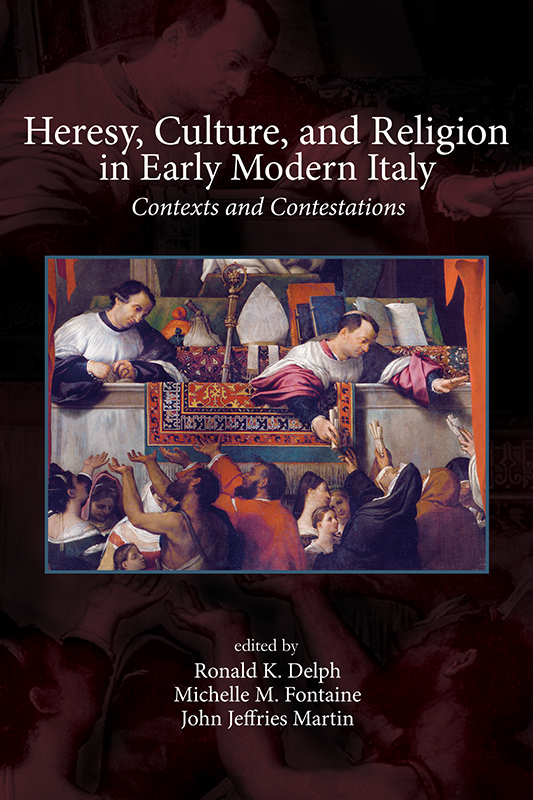
Habent sua fata libelli
S IXTEENTH C ENTURY E SSAYS & S TUDIES S ERIES
General Editor
Raymond A. Mentzer
University of Iowa
E DITORIAL B OARD OF S IXTEENTH C ENTURY E SSAYS & S TUDIES
Elaine Beilin
Framingham State College
Miriam U. Chrisman
University of Massachusetts, Emerita
Barbara B. Diefendorf
Boston University
Paula Findlen
Stanford University
Scott H. Hendrix
Princeton Theological Seminary
Jane Campbell Hutchison
University of WisconsinMadison
Ralph Keen
University of Iowa
Robert M. Kingdon
University of Wisconsin, Emeritus
Mary B. McKinley
University of Virginia
Helen Nader
University of Arizona
Charles G. Nauert
University of Missouri, Emeritus
Theodore K. Rabb
Princeton University
Max Reinhart
University of Georgia
Sheryl E. Reiss
Cornell University
John D. Roth
Goshen College
Robert V. Schnucker
Truman State University, Emeritus
Nicholas Terpstra
University of Toronto
Margo Todd
University of Pennsylvania
Merry Wiesner-Hanks
University of WisconsinMilwaukee
Ronald K. Delph
Michelle M. Fontaine
John Jeffries Martin
Sixteenth Century Essay & Studies 76
Truman State University Press
Copyright 2006 by Truman State University Press, Kirksville, Missouri
All rights reserved. Published 2006.
Sixteenth Century Essays & Studies Series
tsup.truman.edu
Cover Illustration: Lorenzo Lotto, detail of Sant Antonio Altarpiece (154142), oil on panel. Santi Giovanni e Paolo, Venice, photo courtesy of Art Resource.
Cover and title page design: Teresa Wheeler
Type: Minion Pro
Printed by Thomson-Shore, Dexter, Michigan USA
Library of Congress Cataloging-in-Publication Data
Heresy, culture, and religion in early modern Italy : context and contestations / editors, Ronald D. Delph, Michelle M. Fontaine, and John Jeffries Martin.
p. cm. (Sixteenth century essays & studies ; v. 76)
Includes bibliographical references and index.
ISBN-13: 978-1-931112-58-1 (alk. paper)
ISBN-10: 1-931112-58-4 (alk. paper)
1. ItalyChurch history16th century. I. Delph, Ronald K. II. Fontaine, Michelle. III. Martin, John Jeffries, 1951 IV. Series.
BR875.H47 2006
274.5'06dc22
2006017430
No part of this work may be reproduced or transmitted in any format by any means without written permission from the publisher.The paper in this publication meets the minimum requirements of the American National Standard for Information SciencesPermanence of Paper for Printed Library Materials, ANSI Z39.48-1992.
Sequential numbers in square brackets [] in the body of the text refer to page numbers in the print edition; citations appeared as footnotes in the print edition.For Elisabeth Gleason
John Jeffries Martin
Massimo Firpo
Michelle M. Fontaine
Paul V. Murphy
Ronald K. Delph
Frederick J. McGinness
Paolo Simoncelli
Paul F. Grendler
Marion Leathers Kuntz
Silvana Seidel Menchi
Gigliola Fragnito
Elena Bonora
Anne Jacobson Schutte
John W. OMalley
Early modern Italian history has emerged as a major field of study over the last few decades. Only thirty years ago, a famous scholar called the era that fell between the Renaissance and the Risorgimento the forgotten centuries. Today, by contrast, early modern Italy has become the focus of intense study in numerous fields: art history, the history of science, the history of the state, intellectual history, and, not least of all, the history of Christianity.
This volume is concerned with struggles within the dominant religious culture of Italy in the sixteenth and seventeenth centuries. In preparing this anthology, we became acutely aware that the traditional framework of Reformation and Counter-Reformationor of innovation and repressionwithin which many scholars had previously approached this period, was no longer adequate. To be sure, few historians have ever doubted that in this period Italy was full of intellectual and cultural energy; but the Roman Catholic Church established the Inquisition, placed suspicious or possibly subversive texts on an Index of Prohibited Books, burned Giordano Bruno in Rome in 1600, and confined the eloquent court astronomer Galileo to house arrest in 1633 for having maintained too forcefully that the earth was not, as many then taught, at the center of the universe, but rather a moving planet that revolved around the sun. Whatever intellectual energies there were in Italy in this period, therefore, were harshly repressed; and France, Holland, and England emerged as the most dynamic cultures in Europe at this time.
The counterpoint between reason and reform on the one hand and repression and intolerance on the other makes for a seductively appealing story, but, as the contributions in this anthology make clear, new research has challenged this perspective. The early modern men and women who appeared to be at odds with one another were often close friends; ideas that were heterodox at one period were considered entirely orthodox at another; institutions that seemed repressive were at times centers of mediation and compromise; and, perhaps most important, the reforms in religion in this period must now be seen in a larger context of social upheaval and vast cultural changes on a variety of fronts: educational, artistic, scientific, and literary. In short, it now no longer seems possible to view the history of Italy in this period as one in which social forces or religious parties were clearly defined.
The essays in this volume represent these new perspectives. The contributors include two generations of Italian and American scholars. And, while there is no [xii] new consensus that emerges from the works published here, we emerge from this project more convinced than ever that each particular reform movement in Italyboth from the perspective of the reformers and from the perspective of those who sought to either repress them or find other ways to bring them back into the mainstream of Italian pietymust be understood within particular social and political contexts. It is our hope, finally, that this new perspective will serve as a guide to the future studies of religion and cultural change in early modern Italy.
We put this anthology together in the age of e-mail and conference calls. In this high-speed world of instant communication, we have nonetheless had a bit of time to reflect on the fact that, despite profound differences from the religious and scholarly world that existed in Italy many centuries ago, we have much in common with the persons we study. Like sixteenth-century humanists, reformers, and church officials, we too are merely trying our best to make sense of the past and, through the study of the past, to make better sense of the world in which we live. It has been a pleasure for us to deepen our friendships while putting this book together, but each of us is also mindful that we have done this not in isolation from life but in the midst of it. One of us, after careful thought and deliberation, made a major change of emphasis in priorities, moving from the large lecture hall of the university to the smaller classroom of a private secondary school; the other two have felt the strain of trying to explain to their young children that they were busy, of all things, working on the sixteenth century. For all our friends and family who have been supportive of this enterprise, we are extremely grateful. And we offer a special note of appreciation to T. C. Price Zimmermann for his help with the translation of Paolo Simoncellis essay.
Font size:
Interval:
Bookmark:
Similar books «Heresy, Culture, and Religion in Early Modern Italy»
Look at similar books to Heresy, Culture, and Religion in Early Modern Italy. We have selected literature similar in name and meaning in the hope of providing readers with more options to find new, interesting, not yet read works.
Discussion, reviews of the book Heresy, Culture, and Religion in Early Modern Italy and just readers' own opinions. Leave your comments, write what you think about the work, its meaning or the main characters. Specify what exactly you liked and what you didn't like, and why you think so.

